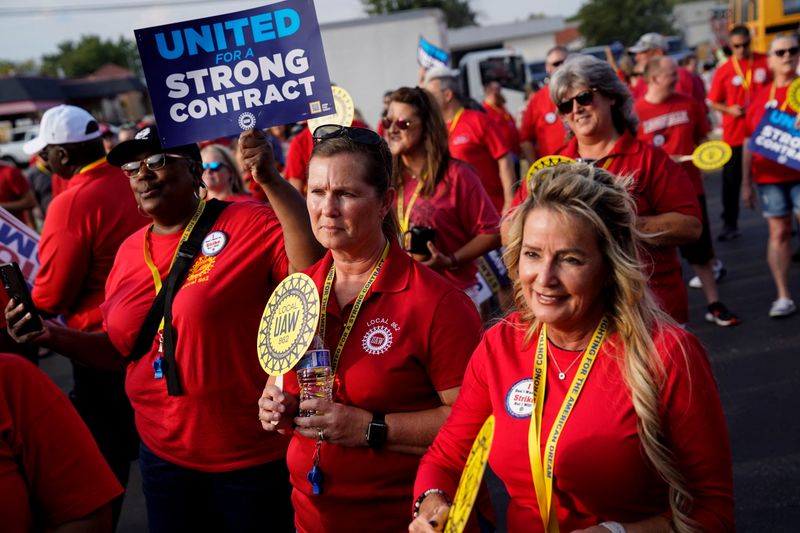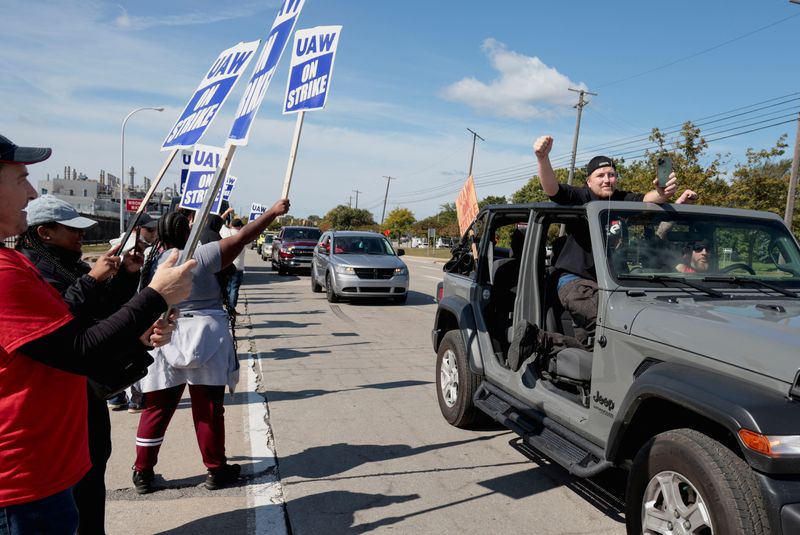(Reuters) - The United Auto Workers (UAW) union on Friday expanded its coordinated U.S. strike against General Motors Co (NYSE:GM) and Stellantis (NYSE:STLA), but said it had made real progress in talks with Ford Motor (NYSE:F).
The ongoing strike is the first-ever simultaneous labor action against General Motors, Ford Motor and Chrysler parent Stellantis after the UAW's contracts expired more than a week ago.
The automakers, like their global counterparts, have been focused on cost reductions, which in some cases include job cuts, to help accelerate a shift to electric vehicles (EVs) from gasoline-powered vehicles.
WHO IS THE UNION NEGOTIATING WITH?
The UAW, which represents 46,000 GM workers, 57,000 Ford employees and 43,000 Stellantis workers, kicked off negotiations with the companies in July.
The union historically has picked one of the Detroit Three to negotiate with first as the so-called target that sets the pattern on which subsequent deals are based. This time, UAW President Shawn Fain targeted all three companies simultaneously.
Contract talks between the UAW and the Detroit automakers in past years had gone on until the strike deadline and beyond. A Reuters/Ipsos poll found significant support by Americans for the striking auto workers.
HOW WIDESPREAD IS THE STRIKE?
The initial walkout of 12,700 workers was smaller than some analysts expected, with only three assembly plants in Michigan, Ohio and Missouri targeted. Those plants build the Ford Bronco, Jeep Wrangler and Chevrolet Colorado, along with other popular models.
The second round of strikes will expand to 38 locations across 20 states in all nine regions of the UAW, focusing on parts distribution centers.
WHAT DOES THE UAW HAVE TO SAY ABOUT THE OFFERS?
The union previously rejected the companies' offers. It has demanded a 40% wage hike, including a 20% immediate increase, and improvements in benefits.
"If they’ve got money for Wall Street, they sure as hell have money for the workers making the product," UAW President Shawn Fain has said.
Fain said on Friday "Stellantis and GM in particular are going to need some serious pushing." He added they have more work to do at Ford, but "we do want to recognize that Ford is showing they're serious about reaching a deal."
WHAT ARE THE CURRENT OFFERS FROM THE DETROIT THREE?
The three automakers currently have proposed 20% raises over four-and-a-half years. In an opinion piece published in the Detroit Free Press, GM President Mark Reuss called the UAW's demands for a 40% pay hike "untenable," signaling the two sides remain far apart over the key issue.
On Friday, Fain said Ford has improved its offer, which includes right to strike over plant closures, additional job security in the event of layoffs and enhanced profit sharing formula.
WHAT IS AT STAKE?
The industrial action hit the Detroit Three automakers as they ramp up efforts to maximize gasoline and EV vehicle production to capitalize on demand for new vehicles.
A full strike would hit earnings at each affected automaker by about $400 million to $500 million per week assuming all production was lost, Deutsche Bank previously estimated. Some losses could be recouped by boosting production schedules later, but that possibility fades if a strike extends to weeks or months.
In fiscal 2019, GM's fourth-quarter profit took a $3.6 billion hit from a 40-day UAW strike.
Morgan Stanley analyst Adam Jonas estimated in a Thursday research note that a full month of lost production would cost the three automakers $7 billion to $8 billion in lost profits.
WHAT ARE THE UNION'S DEMANDS?
The UAW is pushing automakers to eliminate the two-tier wage system under which new hires can earn far less than veterans.
Fain has said repeatedly that the union will push to restore pay improvements tied to the cost of living and retiree benefits cut during the 2008-2009 economic crisis.
The UAW wants strong salary increases, given the financial success of the automakers, citing generous executive payouts and large U.S. federal subsidies for EV sales.
The union also wants defined benefit pensions for all workers restored, 32-hour work weeks, job security guarantees and an end to the use of temporary workers.
Fain also is aiming to get agreements that would allow the UAW to represent hourly workers at joint-venture EV battery plants opened or planned by the Detroit Three.
The UAW has been wary of the industry shift to EVs and called on the Biden administration to soften its proposed vehicle emission cuts that would require 67% of new vehicles to be electric by 2032. The union has yet to endorse a candidate in the next U.S. presidential election.
EVs require fewer parts to build, and industry officials have said that will result in a need for fewer workers. Fain has said there should be no jobs lost because of the EV shift.
WHAT DO AUTOMAKERS WANT?
The Detroit Three want to close the cost gap they have with foreign automakers with non-unionized U.S. factories.

Ford sources estimate that their U.S. labor costs are $64 an hour, compared with an estimated $55 for foreign automakers and $45 to $50 for EV leader Tesla (NASDAQ:TSLA).
The companies also want greater flexibility in how they use their U.S. workforces to increase efficiency and cut costs as the industry shifts to EVs.
